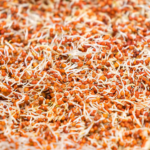Whole grains have long been celebrated as nutrient powerhouses, but not all forms of grains are equally easy on the stomach. For many, grains can feel heavy, sometimes leading to bloating or discomfort. This is where sprouted grains, particularly sprouted ragi (finger millet), step in as a game-changer. Sprouting transforms the humble grain into a more digestible and nutrient-rich food source. Let’s explore the science behind it.
What Happens During Sprouting?
Sprouting is the natural process where a grain begins to germinate after soaking in water. When ragi seeds sprout:
- Enzymes activate: Sprouting stimulates enzymes such as amylase and protease, which start breaking down complex starches and proteins into simpler, more digestible forms.
- Anti-nutrients reduce: Compounds like phytates and tannins—often responsible for binding minerals and making them harder to absorb—decline significantly.
- Nutrient profile improves: Levels of vitamins, especially B-vitamins, vitamin C, and antioxidants, increase during sprouting, enhancing overall nutrition.
Why Sprouted Ragi Is Easier to Digest
1. Breakdown of Starches
Raw grains contain complex starches that the digestive system has to work hard to process. Sprouting pre-digests much of this starch, making it lighter on the gut. This means the body can absorb energy more efficiently without causing a sugar spike.
2. Reduced Anti-Nutrients
Phytates, found in raw grains, block the absorption of minerals like iron, calcium, and zinc. Ragi is already rich in calcium, and sprouting reduces phytates, ensuring that these minerals are more bioavailable and easily absorbed by the body.
3. Enhanced Protein Quality
Proteins in grains can be hard to digest. Sprouting breaks them into amino acids and peptides, making them easier to assimilate while improving the protein’s nutritional quality.
4. Gentle on the Gut
Sprouted ragi is lighter in texture and less likely to cause bloating or heaviness. It supports smoother digestion and better gut comfort compared to its unsprouted counterpart.
Added Nutritional Benefits of Sprouted Ragi
- Calcium boost: Essential for bone health, with higher bioavailability post-sprouting.
- Rich in dietary fiber: Supports healthy bowel movement and satiety.
- Low glycemic index: Helps regulate blood sugar levels, making it a great choice for diabetics.
- Naturally gluten-free: Ideal for those with gluten intolerance or sensitivities.
How to Include Sprouted Ragi in Your Diet
Sprouted ragi can be consumed in multiple ways:
- Sprouted ragi flour for rotis, pancakes, or porridges.
- Ragi malt as a wholesome breakfast drink.
- Baked goods like sprouted ragi bread or cookies.
- Traditional dishes such as idlis and dosas made with sprouted ragi batter.
Final Thoughts
Sprouted grains are nature’s way of making nutrition more accessible to us, and sprouted ragi stands out for its ease of digestion, mineral richness, and gut-friendly properties. By choosing sprouted ragi, you not only give your body a break from heavy digestion but also boost nutrient absorption. Whether you’re focused on wellness, fitness, or managing specific health conditions, sprouted ragi deserves a permanent spot in your diet.




